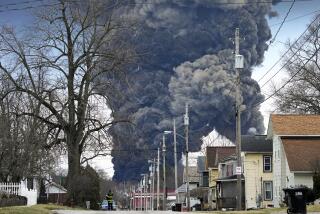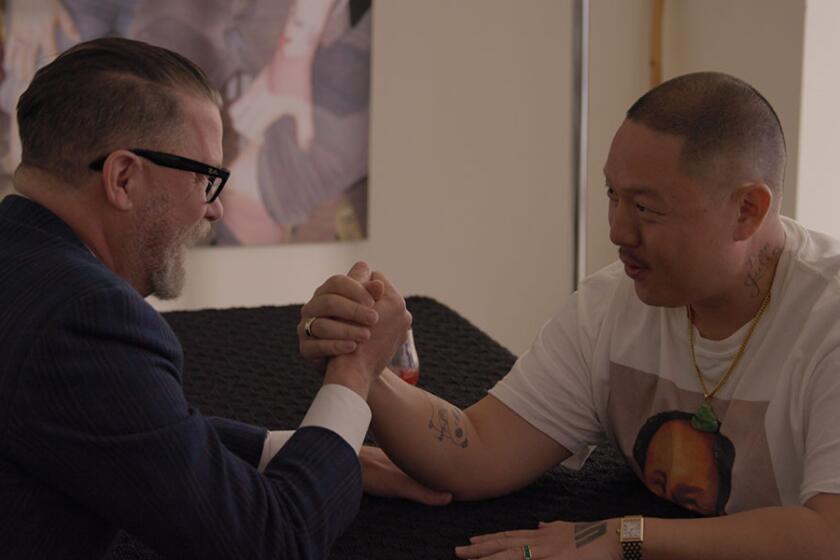A look inside Hollywood and the movies. : How <i> Did </i> They Do That Train Wreck?
At 4:14 a.m. it started. By 4:15 a.m. it was over.
Ten weeks in the planning and 60 seconds in the execution.
“I got up that morning and said to myself, ‘What am I going to do today? I’m going to wreck a train,’ ” laughs co-producer Peter MacGregor-Scott, remembering the one-take-only chance to capture on film a locomotive crashing into a bus stuck on the tracks, derailing and plunging over an embankment to thundering effect in “The Fugitive,” starring Harrison Ford.
The scene has audiences clapping with wonder and amazement, making it one of the most talked about of the summer.
Or, as director Andrew Davis figures, “people are cheering both because they got to go on this ride and because Ford escapes at the last moment. The scope and scale must impress them.” (The movie’s already a hit in its first two weekends.)
It also raises the question in many peoples’ minds whether the filmmakers used actual railcars or just models.
Mostly, it’s the real thing. As both Davis and MacGregor-Scott said in separate interviews, to do otherwise would be “cheating.” Plus, they did it because they could--Warner Bros. budgeted the picture at $70 million, $1.5 million for this sequence alone.
Models had to be used when the locomotive broadsides the prison bus that Ford is trapped in, and footage of Ford running in front of the runaway train was achieved on a soundstage.
The staging of the sequence is being viewed as a new zenith in action movie excitement and certainly is receiving accolades for, if nothing else, an amazing feat of engineering. For two months, the filmmakers took over a section of the privately owned historical Smoky Mountain Railway in Dillsboro, N.C., for its set, one of 106 locations used in the movie.
They went there because no railroad company in five states, including Illinois--Ford’s Dr. Richard Kimble character practices in Chicago--wanted to be linked to such a tragic event, however fictitious.
Working with a second-unit crew of about 70, MacGregor-Scott and special-effects expert Ray Arbogast directed the construction of a 200-yard-long spur that the locomotive runs off on when it is derailed from the main line, disguised so that it looks as if the train is off the tracks.
A team of purchasing agents bought up about-to-be-retired train equipment from railcar brokers across the country, including two locomotives worth about $20,000 apiece, plus box cars, flat cars and a pusher train that would make them go faster than the suggested safe speed of 35 m.p.h.
A couple of dry runs were staged to check the tracks and speed of the trains. Otherwise, it was a one-shot deal that cold late-February morning when “action” was called.
Cameras were set up in 16 locations, many of them remotely operated because it was not considered safe for a camera operator to stand by. Two were mounted on the locomotive itself--one looking forward and another looking back--another inside the bus, others on tripods stationed at regular intervals, another mounted on a crane for an aerial view and a 65-millimeter VistaVision camera was set at ground level. (It took eight hours to unearth the VistaVision camera after the crash; it had been embedded in 26 feet of dirt.) As expected, the trains were annihilated--becoming scrap in an instant--but to the surprise of many, none of the photographic equipment was ruined.
The crew and about 100 curious locals broke out in “whoops and cheers” when the last piece of twisted iron stopped screeching, MacGregor-Scott said. “Sounds you wouldn’t forget for a lifetime,” as he recalls them.
If the train crash is generating all the buzz among moviegoers, it still was less expensive to mount than “the dam fall,” as Davis amusingly titles the other high-action sequence where Ford’s character survives a 225-foot jump off a hydroelectric dam.
The double-entendre would well describe the logistical challenges for working three locations into this same sequence using matte photography, among other movie trickery--again in North Carolina settings because Illinois is flat with no such impressively high dams.
The production secured two-day use of the Cheoah Dam a few miles outside Asheville for the sequence, which begins as Ford is being chased into a mountain road tunnel by lawmen in a helicopter navigated by U.S. Marshal Sam Gerard (Tommy Lee Jones). MacGregor-Scott said sound effects editing of the helicopter rotors help in the illusion as the chopper passes over the matte line from the tunnel location to the footage of the dam that was shot in another part of the state. And the maze of subterranean water tunnels that lead from the mountain tunnel to the dam--where Jones chases Ford--do not exist at all. They were built in a Chicago warehouse at the cost of $400,000, engineered to pump 150,000 gallons of water--enough for a public swimming pool.
The section of the tunnel that opens over the dam where Ford is trapped momentarily by Jones before jumping was actually driven from Chicago to North Carolina by truck and set up high over the Cheoah Dam, creating the illusion that it emptied there.
The producers paid Alcoa, the dam’s operators, for two days’ use of the facility, mostly in water fees of $12,000. The first day, the dam’s sluices were open at full throttle pouring about 150 million gallons an hour. The second day’s shoot, they were shut completely as an unsuccessful search is conducted for Ford’s body. As MacGregor-Scott said: “That’s some water bill.”
To the crew’s amazement, when it came time for an establishing shot where Ford contemplates the jump, the actor decided not to use a stunt double. That’s him on the edge of the dam a mere few feet from a precipitous drop to death (he was held by a wire). It’s also him swimming in the frigid river water after he survives the fall (two Navy SEALs were on hand as advisers). Two takes only for the latter.
“The guy’s got. . . . What can I say,” MacGregor-Scott said.
Six made-to-order Harrison Ford look-alike dummies--valued at a cost of $7,000 to $12,000 apiece--took the real fall. Their dismembered remains were recovered from the spillway at the bottom and returned to their rightful owner. (MacGregor-Scott said the owner was “furious” the dummies were returned in shambles. “He wanted to re-rent them.”)
As Jones, playing U.S. Marshal Sam Gerard, was told by another law enforcement character in the film, anyone who falls that far and in water temperatures hovering around 40 degrees “has a one-in-a-million chance” of living.
Cost for this hair-raising sequence--$2 million.
For director Davis, the train crash establishes Ford as a man of action. The dam scene, he said, establishes the character.
“He makes a conscious decision right then and there. The fall serves as his baptism. That’s when he becomes the fugitive.”
More to Read
Only good movies
Get the Indie Focus newsletter, Mark Olsen's weekly guide to the world of cinema.
You may occasionally receive promotional content from the Los Angeles Times.










